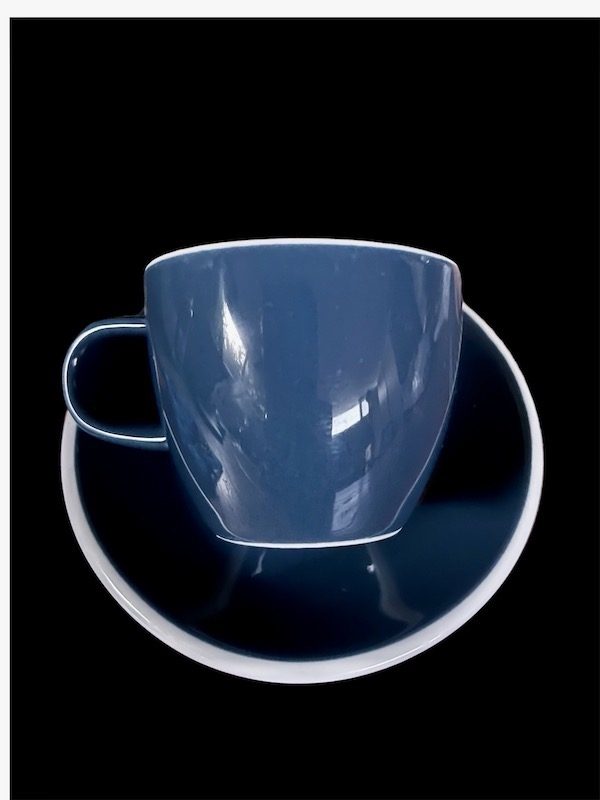Acme Espresso Cup: Designed in New Zealand for the World
(Gerry Furth-Sides) We fell in love with these espresso cups at The Commissary in Culver City. When the staff said they do not sell them, I found them online. Designed in New Zealand, manufactured in Asia, they are sold by the North American distributor, Acme Cups in Calgary, Alberta, Canada. For details, please see: //www.acmecupsusa.com
ACME espresso, and cappuccino cups can be described as whimsical, chic, pretty and bright – with a perfect ergonomically designed fit that fits your fingers and is comfortable for your hands. The little cups are also stylish and long-lasting. (beautiful earthenware cups from the Ivy and from Portugal develop cracking lines in short time).
Acme is the brainchild of Jeff Kennedy – NZ Specialty Coffee Association inaugural Lifetime Achievement Award recipient and Godfather of NZ espresso. Jeff had long wanted to create a cup he wanted, so in 2011 he and partner Bridget Dunn founded the company. Within two years Acme had established itself as the specialty coffee cup market leader in New Zealand, both for design and durability.
We also curious about the origin of this sweet little cup, and were stunned at its relatively recent history! A history of the coffee cup that led to it can be found at: //laboratorioespresso.it/en/coffee-cup-history/
We first learned that classic espresso served also in a glass cup, as it is in the middle east. But the porcelain coffee cup seems preferable since this material conserves heat better and helps to bring out the flavor of the drink more than glass.
In English you say “espresso cup”, but it in Italian it is known as “tazzina” after the last name of its inventor’s last name Luigi Tazzini. The fun part is that every region has its own specific spelling for the word. When you are in Milan you might hear “tazzin”, and when in Naples it might be “tazzulella.”
Gifted artist, Tazzini adored the then emerging movement of Art Nouveau and oriented his production in this direction; the design of the modern coffee cup is all down to him and the definitive addition of the handle. Tazzini developed many different types of this cup, for different purposes: el tazzinin for drinking coffee, el tazzin on the other hand was designed for drinking wine, the tazzinetta for latte, the tazzina for eating pasta with beans.
Tazzini was studying painting at the “Accademia di Brera”, the Academy of Fine Arts in Milan somewhere between the 19th and 20th century. The main contribution was adding a handle to the current version of cups that were very hot to hold!
The story continues when Tazzini was nominated the artistic director of “Società Ceraminca Richard-Ginori”, a company based in Tuscany. He was also an estimator and connoisseur of the Art Nouveau. Thanks to his notoriety he was able to push the production of his new, stylish and very practical little cup, which was especially popular in Milano. For more details, please see //caffeaiello.us/blog/curiosity/history-of-the-traditional-espresso-cup/
The French demitasse cup vies for being the first “espresso” cup. But it means half a coffee cup, which is larger than the amount in an espresso. Of course, the French term “demitasse” originated in France and translates to “half cup”. Their original intended use was for drinking strong espresso coffee after a meal.
The French claim that while Espresso, long considered an integral part of Italian life, actually originated in France in 1822. They also claim that the French invented the espresso machine, but the Italians perfected it into what it is today and it continues to play an important role in daily life.
All in all, the diminutive little cup is called by many different names, depending on which country you are in. Here are some examples: Demitassekop is Dutch, Mokkatasse is German, Tazzina is Italian, Copo demitasse is Portuguese, and Copa tacita or pocillo is Spanish.
While we sort that out, here are our favorite treats to keep company with these wonderful espresso “tazzini”. By whatever name you call them, they somehow make drinking your coffee, tea or chocolate more special.






 Gerry Furth-Sides
Gerry Furth-Sides  Barbara Hansen
Barbara Hansen  Chef-owner Alain Cohen
Chef-owner Alain Cohen  Roberta Deen
Roberta Deen  Jose Martinez
Jose Martinez  Nivedita Basu
Nivedita Basu